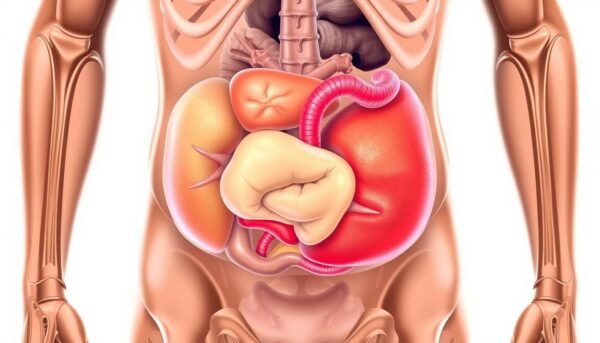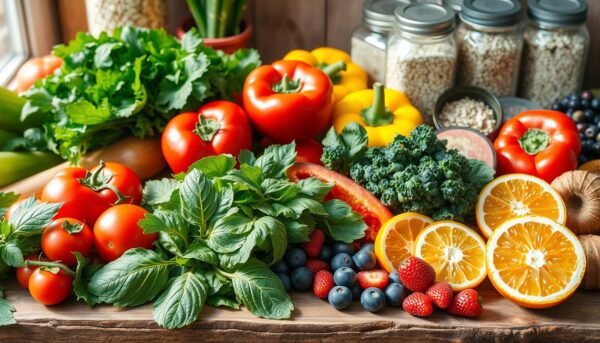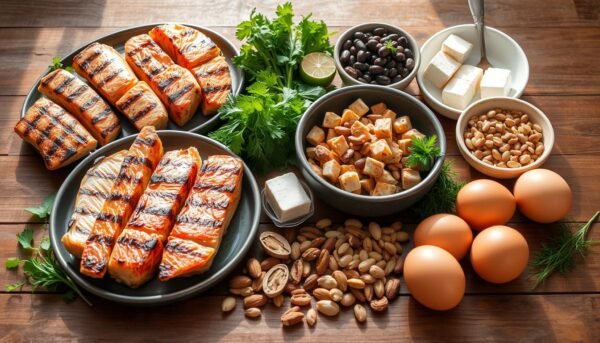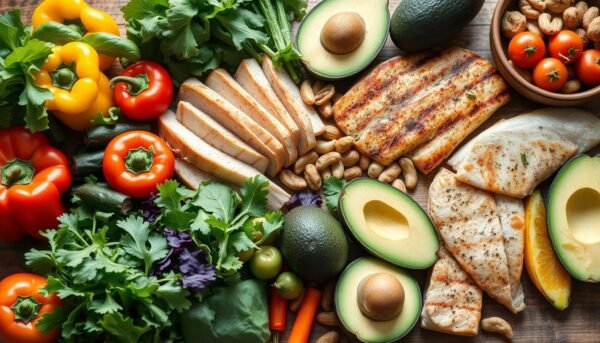Looking in the mirror, I felt frustrated. The belly fat had been there for years. It seemed to laugh at my fitness efforts. But I refused to give up.
Excess belly fat is not just about looks. It can lead to serious health problems like heart disease and diabetes.
If you want to lose belly fat, you’re in luck. Simple exercises and smart eating can help you in 3 months. I’ll share the tips that worked for me and many others.
Let’s start our journey to lose belly fat and boost our confidence. We’ll work together to lose weight and improve our health.
Understanding Belly Fat and Its Health Impacts

Not all fat is the same. Visceral fat is bad because it’s deep in the belly near organs. It’s linked to diabetes, heart disease, and more.
Types of Abdominal Fat and Risk Factors
Subcutaneous fat is under the skin, making the belly look softer. It’s not as bad as visceral fat.
Visceral fat is around organs like the heart and liver. It raises the risk of insulin problems and inflammation. People with too much visceral fat are three times more likely to get certain cancers.
Why Targeting Belly Fat Matters for Overall Health
Keeping a healthy weight is key for feeling good. BMI shows weight, but not fat type. Focusing on belly fat, especially visceral, helps a lot.
Knowing about belly fat types helps us choose better. We can reduce visceral fat with good food, exercise, and lifestyle changes. This improves body shape and health.
Essential Nutrition Guidelines for Fat Loss

Starting a healthy diet is key to losing fat. To lose belly fat, aim for a 500-1000 calorie deficit each day. This can be done by eating less and moving more. This safe method helps you lose 1-2 pounds a week.
When cutting calories, choose whole foods that boost your metabolism. Lean proteins like chicken, fish, and legumes are important. They help keep your muscles while you lose weight. Add fruits, veggies, and whole grains to meet your nutrient needs.
Adding these superfoods to your diet can help with fat loss:
- Nuts and seeds, like almonds and chia seeds, are full of healthy fats, fiber, and protein.
- Green tea has caffeine and antioxidants that may boost fat burning.
- Whole grains, such as oats and brown rice, give lasting energy and help control blood sugar.
- Avocados are a good source of monounsaturated fats that can reduce belly fat and improve heart health.
Limit sugar-sweetened drinks, refined carbs, and alcohol. They can lead to extra calories and fat around your waist.
| Food Group | Metabolism Boosting Options | Foods to Limit |
|---|---|---|
| Proteins | Lean meats, poultry, fish, legumes, eggs | Fried or high-fat meats |
| Carbohydrates | Whole grains, fruits, vegetables | Refined carbs, added sugars |
| Fats | Nuts, seeds, avocado, olive oil | Fried foods, high-fat baked goods |
| Beverages | Water, unsweetened tea, black coffee | Sugary drinks, alcohol |
Follow these nutrition tips and exercise regularly. You’ll be on your way to a healthy diet, metabolism boosters, and calorie deficit for lasting fat loss.
The Role of Protein in Burning Belly Fat

Keeping a healthy amount of protein is key for losing belly fat. Protein helps you feel full, boosts your metabolism, and keeps your muscles strong when you eat fewer calories.
Best Protein Sources for Weight Loss
To get the most fat-burning benefits from protein, choose lean and high-quality sources. Here are some top picks:
- Lean meats like chicken, turkey, and lean beef
- Fish and seafood, such as salmon, tuna, and shrimp
- Eggs and dairy products like Greek yogurt and cottage cheese
- Legumes, lentils, and beans
- Whey protein powder, which can be a convenient supplement
Daily Protein Requirements for Fat Loss
The daily protein needed for weight loss is 0.5 to 1 gram per pound of body weight. For a 150-pound person, that’s 75-150 grams of lean protein daily. Eating protein-rich foods every 3-4 hours keeps you full and helps with weight loss.
| Gender | Recommended Protein Intake |
|---|---|
| Women | 46 grams per day |
| Men | 56 grams per day |
Focus on lean protein intake and eat a variety of protein-rich foods. This boosts your body’s fat-burning ability and supports your health and wellness.
High-Impact Cardio Exercises to Lose Belly Fat

To lose belly fat, you need good cardio exercises and a healthy diet. High-intensity workouts boost your metabolism and burn calories. Let’s look at some effective cardio exercises for fat loss.
Burpees: The Total-Body Blaster
Burpees are great for losing belly fat. They work your whole body, burning calories fast. Do 3 sets of 10-12 reps to increase your heart rate and burn fat.
Mountain Climbers: Ignite Your Core
Mountain climbers are excellent for your core and heart rate. Start in a plank, then bring your knees to your chest quickly. Do 30-40 seconds or 10-15 reps to sweat and burn calories.
Jump Squats: Explosive Power
Jump squats boost your cardio and burn belly fat. Stand wide, squat, then jump up with arms overhead. Do 3 sets of 12-15 reps to pump your heart and metabolism.
For fat loss, choose medium to high-intensity cardio. This keeps your heart rate up and burns calories. Aim for 300 minutes of cardio weekly, or 45-60 minutes daily, to lose belly fat.
| Exercise | Optimal Sets/Reps | Benefits |
|---|---|---|
| Burpees | 3 sets of 10-12 reps | Highly efficient calorie-burning, targets full body |
| Mountain Climbers | 3 sets of 30-40 seconds or 10-15 reps | Engages the core, elevates heart rate |
| Jump Squats | 3 sets of 12-15 reps | Explosive power, boosts metabolism |
Core-Strengthening Workouts for a Flat Stomach

To get a flat stomach, you need more than just crunches and sit-ups. You must do exercises that work your abdominal muscles from all sides. This way, you can lose belly fat and get a stronger, more toned core.
Effective Plank Variations
The plank is great for working your abdominal muscles, back, and shoulders. Try these plank variations to challenge your core:
- Standard Plank: Hold a high plank position with your arms extended and your body in a straight line from head to heels.
- Side Plank: Lie on your side with your elbow under your shoulder, and lift your hips off the ground, forming a straight line from your head to your feet.
- Reverse Plank: Sit on the ground with your legs extended, then lean back and place your hands behind you, lifting your hips off the ground.
Russian Twists and V-Crunches
Exercises that target your obliques, the muscles on the sides of your abdomen, can help create a sleek, tapered waistline. Two effective moves are:
- Russian Twists: Sit on the floor with your knees bent and your feet lifted. Twist your torso from side to side, tapping your hands on the ground beside you.
- V-Crunches: Lie on your back with your legs extended and your arms extended overhead. Simultaneously lift your upper body and your legs, forming a “V” shape with your body.
Do 3-4 rounds of each exercise, with 30-second intervals and 1-minute rest periods between rounds. Regular core-strengthening workouts and a balanced diet can help you get a flat, sculpted stomach.
Smart Carbohydrate Management for Weight Loss

Managing carbs is key to losing belly fat. Low-carb diets help a lot, especially for those who are overweight. They also help people with type 2 diabetes or PCOS.
It’s important to swap out bad carbs for good ones. Bad carbs include white bread, pasta, and sugary snacks. Good carbs are whole grains like brown rice, quinoa, and oats.
- A typical low-carb diet limits carb intake to less than 26% of total daily calories, which equals fewer than 130 grams of carbs for a 2,000-calorie diet.
- Popular low-carb eating patterns include the Ketogenic (keto) diet, Atkins diet, South Beach diet, Paleo diet, and Dukan diet.
- Foods to emphasize on a low-carb diet include meat, fish, eggs, non-starchy vegetables, lower-carb fruits, nuts and seeds, high-fat dairy, and healthy fats.
By choosing whole grains and low-carb foods, you can help with weight loss. Also, making small changes can make it easier to stick to a low-refined carb diet.
The Connection Between Sleep and Belly Fat

Getting a good night’s sleep is key for your health and weight loss. Poor sleep can lead to more belly fat, harming your health. Knowing how sleep affects metabolism helps us improve our sleep and lose belly fat.
Optimal Sleep Duration for Fat Loss
Studies show 7 to 9 hours of sleep is best for losing fat. Sleeping less than 7 hours can lead to weight gain, especially around the belly. This is because lack of sleep messes with hunger hormones, making us want more food.
Creating a Healthy Sleep Routine
To lose weight, you need a good sleep routine. Try to sleep and wake up at the same time every day. Stay away from screens and bright lights before bed to help you sleep better.
Make your bedroom dark, quiet, and cool for better sleep. Relax with meditation, stretching, or deep breathing before bed. Good sleep boosts energy and helps burn fat.
| Sleep Duration | Potential Impact on Weight Loss |
|---|---|
| Less than 7 hours | Increased risk of weight gain and abdominal fat accumulation |
| 7-9 hours | Optimal range for supporting weight loss and metabolism |
| More than 9 hours | May be associated with increased weight and BMI, though more research is needed |
Good sleep and a healthy routine boost your body’s fat-burning. It’s a key part of losing weight and getting a flat stomach.
Stress Management Techniques to Reduce Fat Storage

Too much belly fat is a big worry for many. High stress makes it worse. Stress raises cortisol, a hormone that boosts hunger and fat storage around the waist.
Women with bigger waists often have more cortisol when stressed. This is a big problem.
To fight this, add stress-reducing activities to your day. Some good ways include:
- Yoga and Meditation – These practices lower cortisol and bring calm.
- Deep Breathing Exercises – A few minutes of slow, deep breaths can calm you down.
- Regular Physical Activity – Exercise, like cardio or strength training, helps reduce stress.
- Time Management – Organizing your tasks and setting achievable goals can make you feel more in control.
By managing stress, you support your weight loss and reduce belly fat. Keeping a balance between stress and calm is essential for reaching your fitness goals.
| Stress Reduction Technique | Benefits for Belly Fat Loss |
|---|---|
| Yoga and Meditation | Lower cortisol levels, promote relaxation |
| Deep Breathing Exercises | Instantly reduce stress and anxiety |
| Regular Physical Activity | Powerful stress-relieving tool, burn calories |
| Time Management | Feeling more in control, less overwhelmed |
Hydration Strategies to Support Fat Loss

Drinking enough water is key for weight control and health. It boosts your metabolism, cuts hunger, and encourages better food choices. Adding water to your weight loss plan can help you reach your goals.
Daily Water Requirements
Adults should drink about 64 ounces or 8 glasses of water daily. But, your needs can change based on age, activity, and where you live. Listen to your body’s thirst and check your urine color to stay hydrated.
Best Times to Drink Water
- Start your day with water to hydrate and boost your metabolism.
- Drink water before meals to feel fuller and eat less.
- Stay hydrated during workouts to support your effort and avoid dehydration.
Avoid sugary drinks like soda and juice. They add too many calories and sugar. Instead, drink plain water all day. You can add fruits or herbs for flavor without sugar.
| Research Findings | Impact on Weight Loss |
|---|---|
| A 2023 study found that drinking 200–250 milliliters of warm water after meals helped people lose more weight and had a lower BMI. | Warm water may increase metabolism and make you feel full, leading to eating less and losing more weight. |
| A 2013 study showed that drinking one extra cup of water daily helped prevent weight gain over four years. | Switching to water instead of high-calorie drinks can help manage weight by cutting down on calories. |
| A 2019 review found that drinking more water was linked to losing 5% of body weight on average. | Being well-hydrated can help with weight loss by boosting metabolism, reducing hunger, and lowering calorie intake. |
By following these hydration tips, you can support your body’s water intake, metabolism, and hydration. This can be a big help in losing belly fat and reaching a healthier weight.
Foods to Avoid When Trying to Lose Belly Fat
Want to lose belly fat? Watch what you eat. Avoid processed foods, sugary snacks, and refined carbs. They can stop your weight loss and add to belly fat. Here are the foods to steer clear of.
- Doughnuts: One glazed doughnut has 260 calories. A whole box is 3,120 calories. That’s like running 25 miles to burn one doughnut!
- Ice Cream: Ice cream is tasty but has 230 calories per half-cup. Choose slow-churned versions for 100 calories per half-cup.
- Potato Chips: Fifteen chips have 160 calories. With 2 tablespoons of French onion dip, it’s 220 calories. Fat-free popcorn is better, with 100 calories for six cups.
Sugary drinks like regular soda add a lot to sugar intake and belly fat. A 20-ounce bottle has 250 calories. Drink water or nonfat milk instead.
Choose whole, healthy foods to nourish your body. They help you lose belly fat. Smart food choices lead to a flatter, toned midsection.
Creating a Sustainable Three-Month Action Plan
Starting my journey to lose belly fat, I know a good plan is key. I don’t want quick weight loss that’s hard to keep up. Instead, I aim for slow, steady changes that help me keep going.
For the next three months, I’ll track my progress with a journal. I’ll weigh myself and take body measurements often. This way, I can see what’s working and make changes as needed. It’s a way to celebrate small wins and stay motivated.
To keep my weight loss plan working, I’ll talk to a health expert. They can help me with a balanced diet and a good exercise plan. They’ll also help me deal with stress and sleep issues that might affect my belly fat. With their help, I’ll get a plan that fits me best, making it easier to reach my goals.
This post may contain affiliate links which means I may receive a commission for purchases made through links. I will only recommend products that I have personally used! Learn more on my Private Policy page.